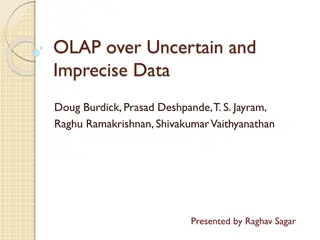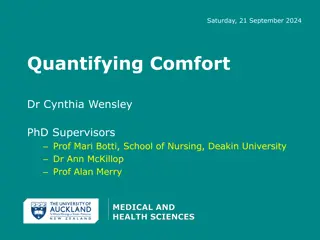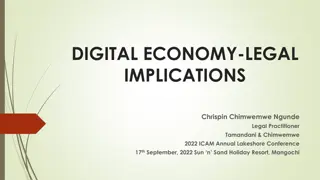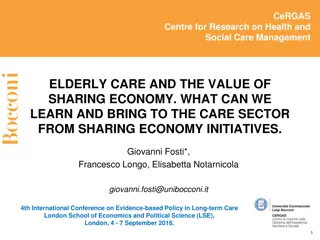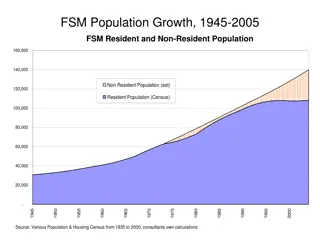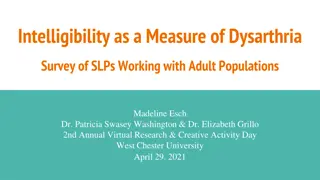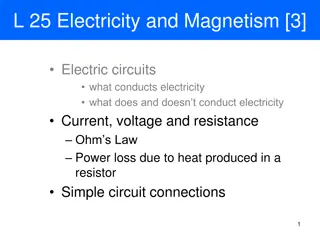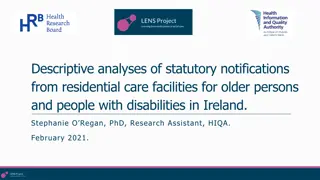The Care Economy in an Uncertain Future: Quantifying Current and Future Trends
This research focuses on quantifying the care economy by analyzing both paid and unpaid care work across different age groups and sexes. Utilizing methodologies like National Transfer Accounts and National Time Transfer Accounts, the study aims to provide policymakers with data on the current landscape and potential future scenarios of the care economy. By combining existing estimates with change scenarios, insights can be gained into the evolving dynamics of care work in society.
Uploaded on Sep 21, 2024 | 0 Views
Download Presentation

Please find below an Image/Link to download the presentation.
The content on the website is provided AS IS for your information and personal use only. It may not be sold, licensed, or shared on other websites without obtaining consent from the author. Download presentation by click this link. If you encounter any issues during the download, it is possible that the publisher has removed the file from their server.
E N D
Presentation Transcript
The Care Economy in an Uncertain Future Gretchen Donehower University of California at Berkeley 13th Global Meeting on Population and the Generational Economy, hosted by the East-West Center August 3, 2020
Objectives Give policymakers quantified data on the current care economy Consistent over time, comparable across places Includes paid and unpaid care work Can be used with available population projections Combine current estimates with change scenarios to envision impacts on future care economy
Roots of the Methodology National Transfer Accounts (NTA) quantifies market-based consumption and production by age and sex Pull out those pieces that relate to the care economy: childcare workers, home health aides, adult daycare workers, household service providers National Time Transfer Accounts (NTTA) quantifies consumption and production of unpaid care work by age and sex Direct care for children, elders, sick and disabled; indirect care through housework and household management
Snapshot UCW Production Unpaid care work (UCW) Pooled 3-yr samples from American Time Use Survey Age profile is smoothed avg time spent in those activities
Snapshot UCW Production Unpaid care work (UCW) Pooled 3-yr samples from American Time Use Survey Age profile is smoothed avg time spent in those activities
Snapshot UCW Consumption Imputed based on Production estimates Household structure Imputation method differs by type of care Direct versus indirect Household member versus non-household member
Snapshot UCW Consumption Imputed based on Production estimates Household structure Imputation method differs by type of care Direct versus indirect Household member versus non-household member
Snapshot PCW Production Current Population Survey Age profile is smoothed avg time reported working in PCW occupations Childcare workers Home health aides Adult daycare workers Household service providers
Snapshot PCW Production Current Population Survey Age profile is smoothed avg time reported working in PCW occupations Childcare workers Home health aides Adult daycare workers Household service providers
Snapshot PCW Consumption Imputed based on CE survey spending on personal services Imputation method differs by type of care Direct versus indirect Adjusted to hours by matching to aggregate hours in PCW production estimate
Snapshot PCW Consumption Imputed based on CE survey spending on personal services Imputation method differs by type of care Direct versus indirect Adjusted to hours by matching to aggregate hours in PCW production estimate
Context: Population Aging How will care economy be impacted by aging? Weight age profiles by population projections Take ratios of aggregate care production / consumption (care support ratios) Thought experiment: if individuals stay the same but the population changes
Care support ratios (2030 relative to 2015) No evidence of supply shortfall UCW 1.2 UCW, Direct 1.4 Time-expensive kids replaced by time-generative older persons UCW, Indirect 1.1 PCW 1.7 Picture changes over longer time spans and within different types of care PCW, Direct 1.8 PCW, Indirect 1.4 0 1 2
What could go wrong? Schools *never* reopen? Increases peak childcare burden by over an hour/day Quantity-quality tradeoff Childcare burden constant even with falling fertility Increasing dementia prevalence Erodes care support ratios but very sensitive to change scenario Change in immigration policy that impact supply of PCW providers


